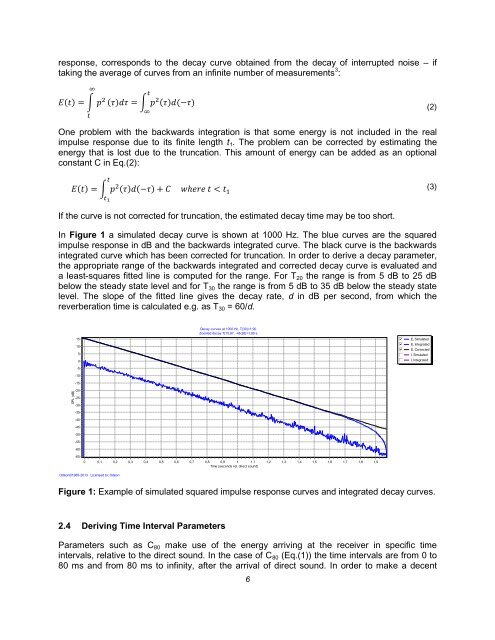paper - Odeon
paper - Odeon
paper - Odeon
Create successful ePaper yourself
Turn your PDF publications into a flip-book with our unique Google optimized e-Paper software.
SPL (dB)<br />
response, corresponds to the decay curve obtained from the decay of interrupted noise – if<br />
taking the average of curves from an infinite number of measurements 3 :<br />
(2)<br />
One problem with the backwards integration is that some energy is not included in the real<br />
impulse response due to its finite length t 1 . The problem can be corrected by estimating the<br />
energy that is lost due to the truncation. This amount of energy can be added as an optional<br />
constant C in Eq.(2):<br />
(3)<br />
If the curve is not corrected for truncation, the estimated decay time may be too short.<br />
In Figure 1 a simulated decay curve is shown at 1000 Hz. The blue curves are the squared<br />
impulse response in dB and the backwards integrated curve. The black curve is the backwards<br />
integrated curve which has been corrected for truncation. In order to derive a decay parameter,<br />
the appropriate range of the backwards integrated and corrected decay curve is evaluated and<br />
a least-squares fitted line is computed for the range. For T 20 the range is from 5 dB to 25 dB<br />
below the steady state level and for T 30 the range is from 5 dB to 35 dB below the steady state<br />
level. The slope of the fitted line gives the decay rate, d in dB per second, from which the<br />
reverberation time is calculated e.g. as T 30 = 60/d.<br />
Decay curves at 1000 Hz, T(30)=1,90<br />
Zoomed decay T(15,67, -46,26)=1,90 s<br />
15<br />
10<br />
5<br />
0<br />
gfedcb<br />
gfedcb<br />
gfedcb<br />
gfedc<br />
gfedc<br />
E, Simulated<br />
E, Integrated<br />
E, Corrected<br />
I, Simulated<br />
I, Integrated<br />
-5<br />
-10<br />
-15<br />
-20<br />
-25<br />
-30<br />
-35<br />
-40<br />
-45<br />
-50<br />
-55<br />
-60<br />
-65<br />
0<br />
0,1<br />
0,2<br />
0,3<br />
0,4<br />
0,5<br />
0,6<br />
0,7<br />
0,8 0,9 1 1,1<br />
Time (seconds rel. direct sound)<br />
1,2<br />
1,3<br />
1,4<br />
1,5<br />
1,6<br />
1,7<br />
1,8<br />
1,9<br />
<strong>Odeon</strong>©1985-2013 Licensed to: <strong>Odeon</strong><br />
Figure 1: Example of simulated squared impulse response curves and integrated decay curves.<br />
2.4 Deriving Time Interval Parameters<br />
Parameters such as C 80 make use of the energy arriving at the receiver in specific time<br />
intervals, relative to the direct sound. In the case of C 80 (Eq.(1)) the time intervals are from 0 to<br />
80 ms and from 80 ms to infinity, after the arrival of direct sound. In order to make a decent<br />
6
















